October 2010
After a very productive banding month in September, October began with a huge push of birds moving through our region. The "busiest" and most diverse day of the year at Powdermill occurred on October 3 when we banded 492 birds of 48 different species. Kinglets were the most common species for the day and we banded 72 Golden-crowned and 62 Ruby-crowned Kinglets. Fortunately, we had a lot of help from our dedicated volunteer crew, and all of the birds were banded, processed, and released safely and efficiently.
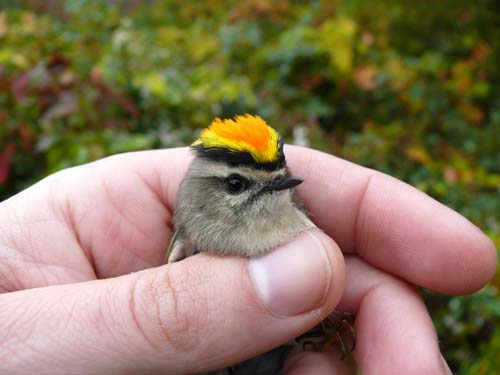
Occasionally, a kinglet in the hand will show it’s agitation by raising its crest, as did this male Golden-Crowned Kinglet. Although he remained thoroughly unhappy as we processed him, and was very glad to leave us, we couldn’t help but admire his magnificent, vibrant orange and yellow display. Female GCKI’s can be distinguished from males by the absence of the orange stripe within the golden ‘crown’.
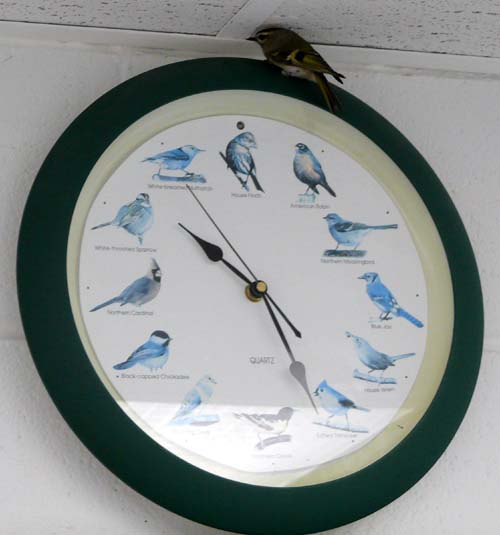
One of the kinglets banded that day got out in the lab and found a resting place near some familiar faces on the bird clock.
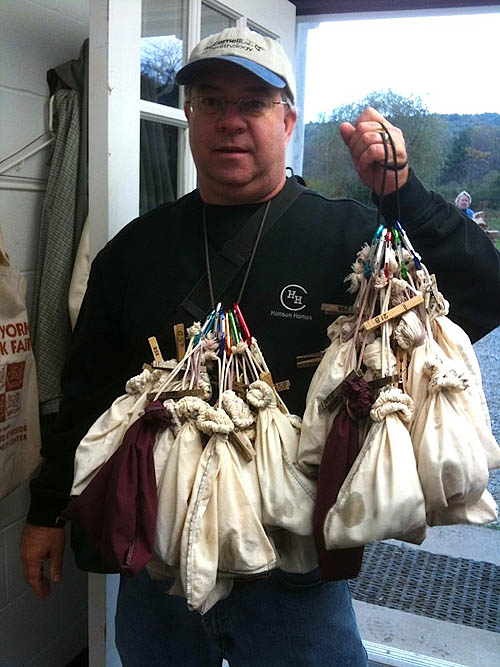
Jeff bringing in birds to the lab for banding and processing. Very early in the morning it was clear we were in for a busy day (Oct 3).
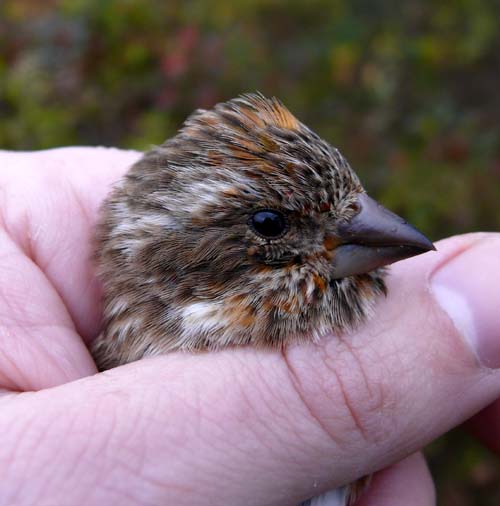
A Purple Finch with yellow rather than purple coloration. We had an average year for PUFIs, banding 189 individuals.
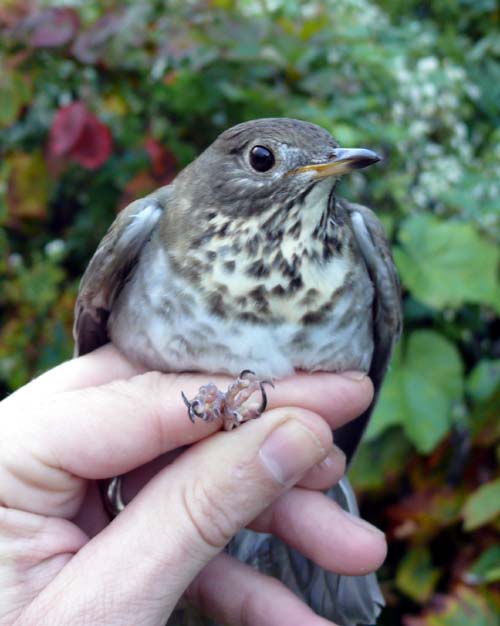
This AHY Gray-cheeked Thrush was noticeably large in the hand and was close to setting a record for both wing length and mass. With a PARC fat score of 3, this thrush weighed in at 52.4 grams, which makes him the fourth-heaviest ever banded at this station. [Previous records: 56.0g on 05/21/2002, 52.7g on 10/20/2002 and 52.6 on 10/08/1966]. A wing length of 109.0 mm puts this individual at the top of that category as well, with only a dozen other GCTH’s having a wing length of 109 or greater (with 110.0 being the record, shared by four GCTH’s).

Although we did not see the large flights of robins that were being reported in some areas, we did capture 21 of them. This individual was identified as a hatching-year bird from the presence of molt limits among the wing coverts. Generally, robins show a molt limit within the greater coverts; however, this bird had replaced all of its greater coverts, the carpal covert, and the first alula feather (arrow pointing to this feather). The larger 2 alula feathers and all the primary coverts are retained juvenile feathers and have a washed-out, brownish appearance.
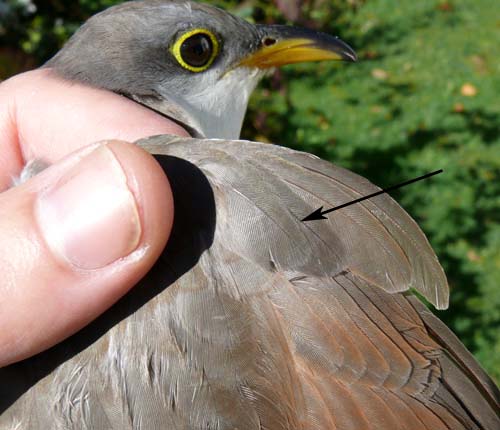
This Yellow-billed Cuckoo was also identified as hatch-year bird for much of the same reason as the robin (above). This individual had 4 alula feathers and the smaller 2 were replaced during the 1st pre-basic molt (darker and richer color), while the larger 2 alula feathers were retained juvenile. The color of the orbital ring also can be useful when ageing cuckoos. The yellow ring characteristic of juveniles turns grayish in adults. For North American cuckoos the 1st pre-basic molt is incomplete to complete. It is a protracted molt that begins on the breeding grounds and completes on the wintering grounds (South America).
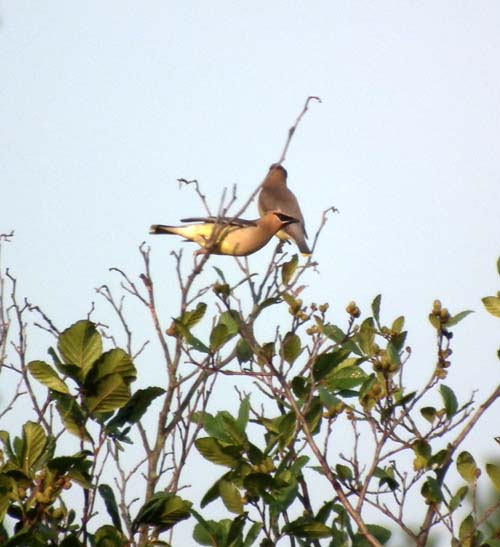
Two Cedar Waxwings foraging in the banding area. After having a very good spring for waxwings, we banded only 102 of them during the fall migration, well below our season average.
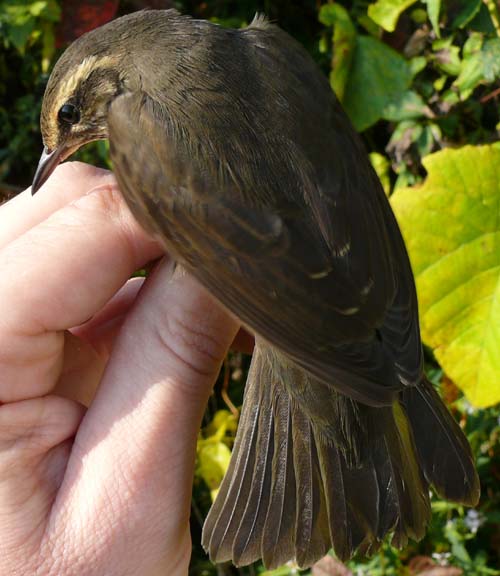
We captured a number of warblers late in migration.
Notice the buffy tipping on the tertials of this hatching-year Northern Waterthrush (adults will lack feature). Although it is more pronounced in this individual, this is a useful characteristic to use when trying to determine the age for both species of waterthrush. Look for rusty tipping on the tertials of juvenile Ovenbirds as well. Although this feature can be useful when ageing fall birds, the tipping often wears off by the spring migration.
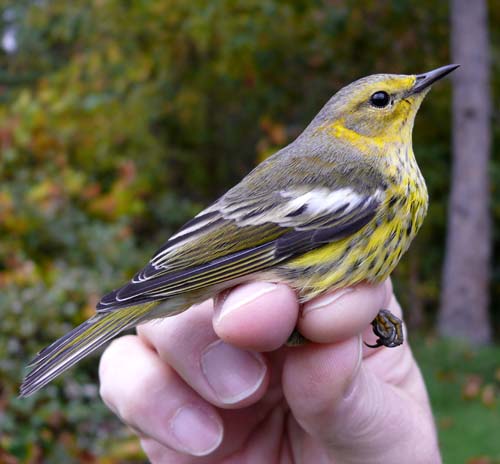
A hatching-year male Cape May Warbler "posing" for the camera. This was the final Cape May of the season and was banded on October 15. In total, we banded 82 Cape May Warblers this fall, which was nearly 6x as many as last fall and the highest number of captures since 1995. Through the 1970s-80s populations of this species fluctuated dramatically, and it wasn't uncommon to band several hundred during a fall season.
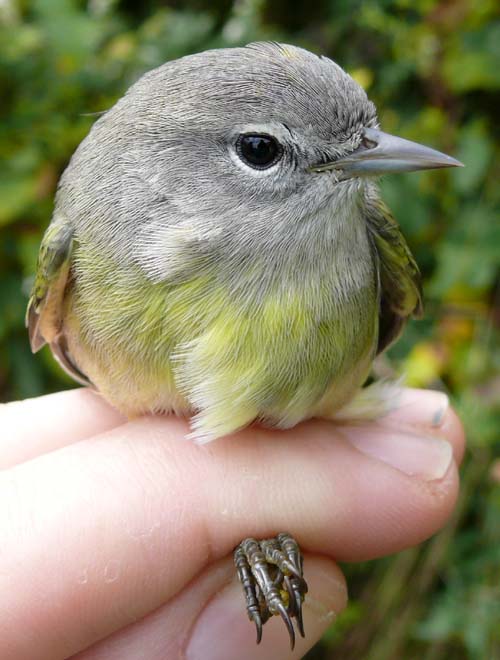
This Orange-crowned Warbler is often considered a "confusing fall warbler" and is a late migrant relative to the majority of warbler species. We never capture a lot of Orange-crowned Warblers (much more common in the western United States), but the 9 banded this fall was considerably higher than our average of 5.8.
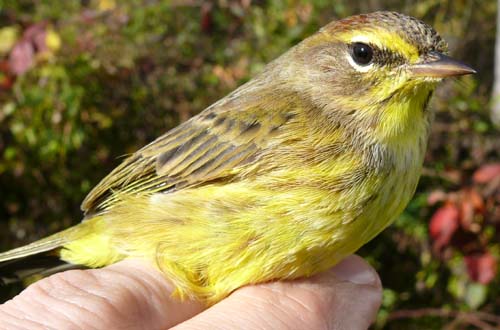
The majority of Palm Warblers banded at Powdermill belong to the western population, but we also capture the occasional bird from the eastern population. Pictured is an example of the Yellow Palm Warbler (eastern population). Individuals from the western population have much less yellow throughout the underparts.
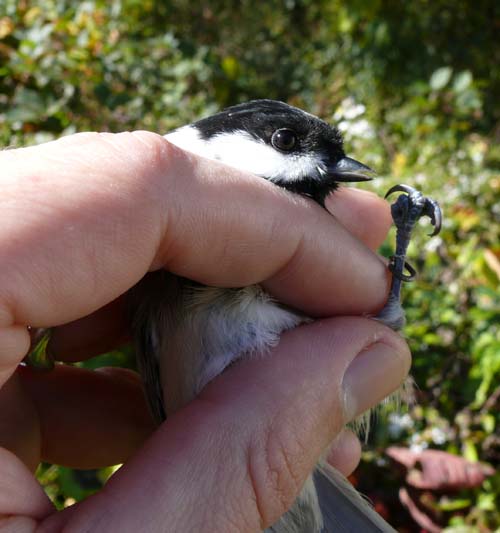
Although this Black-capped Chickadee was captured early in the fall, there was a large movement of chickadees throughout eastern North America at the end of October. This individual was interesting because it was already "banded" when extracted from the net. A plant tendril (probably from a grape vine) was wrapped around this bird's leg. Grape vine is frequently used in nest construction by open-cup nesting birds, likely a result of its antibacterial properties. However, it is unlikely that the grapevine banding occurred in the nest, as chickadees are cavity nesters that do not typically use grapevine as a nest building material. It is more likely that it occurred while the bird was foraging in a cluster of grape vine. It is easy to imagine that the bird's leg could have gotten caught in a dead tendril that broke away from the plant once the bird flew. We supplied this bird with a metal band, removed the tendril, and release it back into the wild.
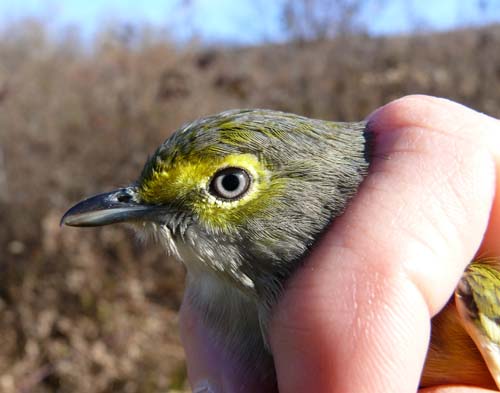
We were surprised to see this late migrant HY White-eyed Vireo in the net on November 12, but it wasn’t until later that we realized it represented a new record. Powdermill’s previous latest date for a WEVI was November 8, a record that had stood for 43 years, since 1967!
Two other close contenders were a WEVI banded on 10/27/2005 that was recaptured on 10/29/2005; and an individual that was first banded on 10/09/1991 that was subsequently caught on October 10th, 19th, and finally on the 27th of that same year.

This Yellow-bellied Sapsucker, captured on November 7, was the last of three caught this Fall. All three were juvenile (HY) males. Female YBSA’s also have a red crest, but lack the red on the throat.
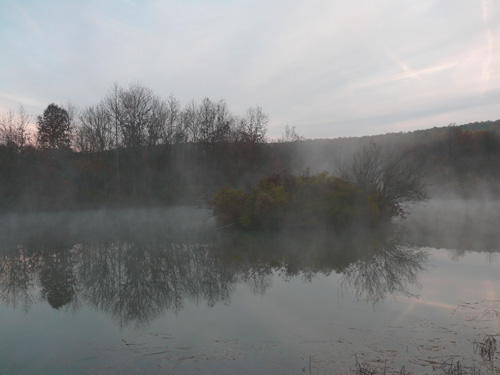
Early morning in late fall with fog rising off of Crisp Pond.
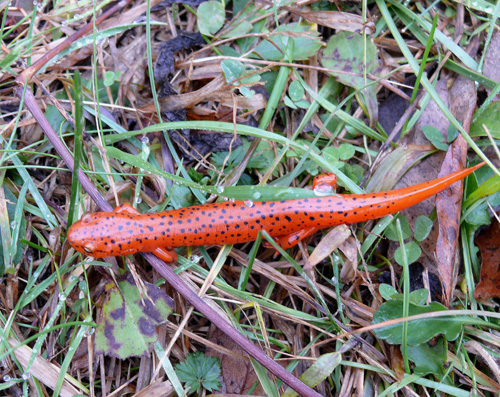
A Northern Red Salamander walking along a net lane. These are not commonly found at Powdermill and are usually underneath logs.
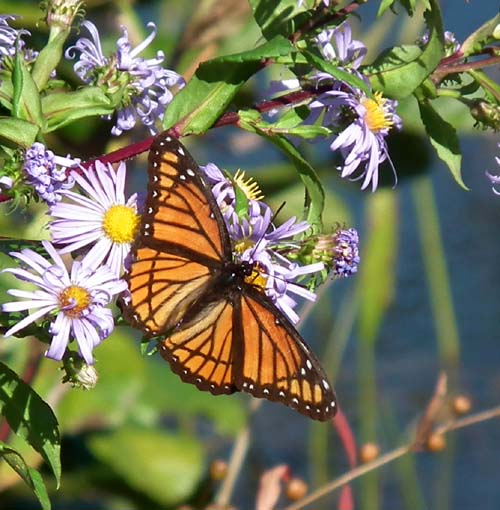
A Viceroy. This butterfly is very similar in appearance to the Monarch but is a little smaller and has the curved line across the hindwing. Its larvae feed on willow and popular and the butterflies are usually found in close proximity to those plants (both willow and popular are abundant in the banding area). Like the Monarch, the Viceroy is distasteful to predators, making their similar appearance a case of Mullerian (rather than Batesian) mimicry.
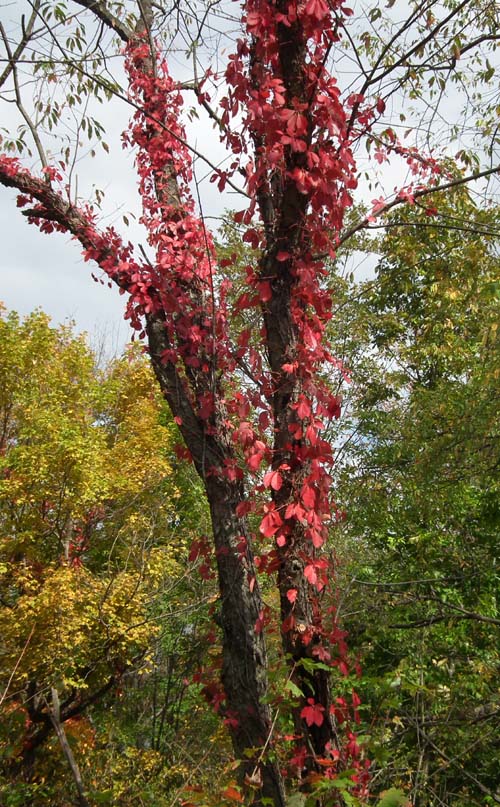
Virginia Creeper
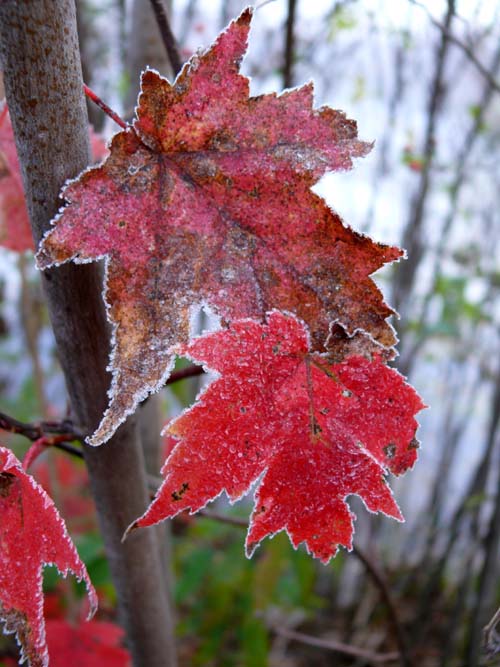
The serrated leaf of a Red Maple.
